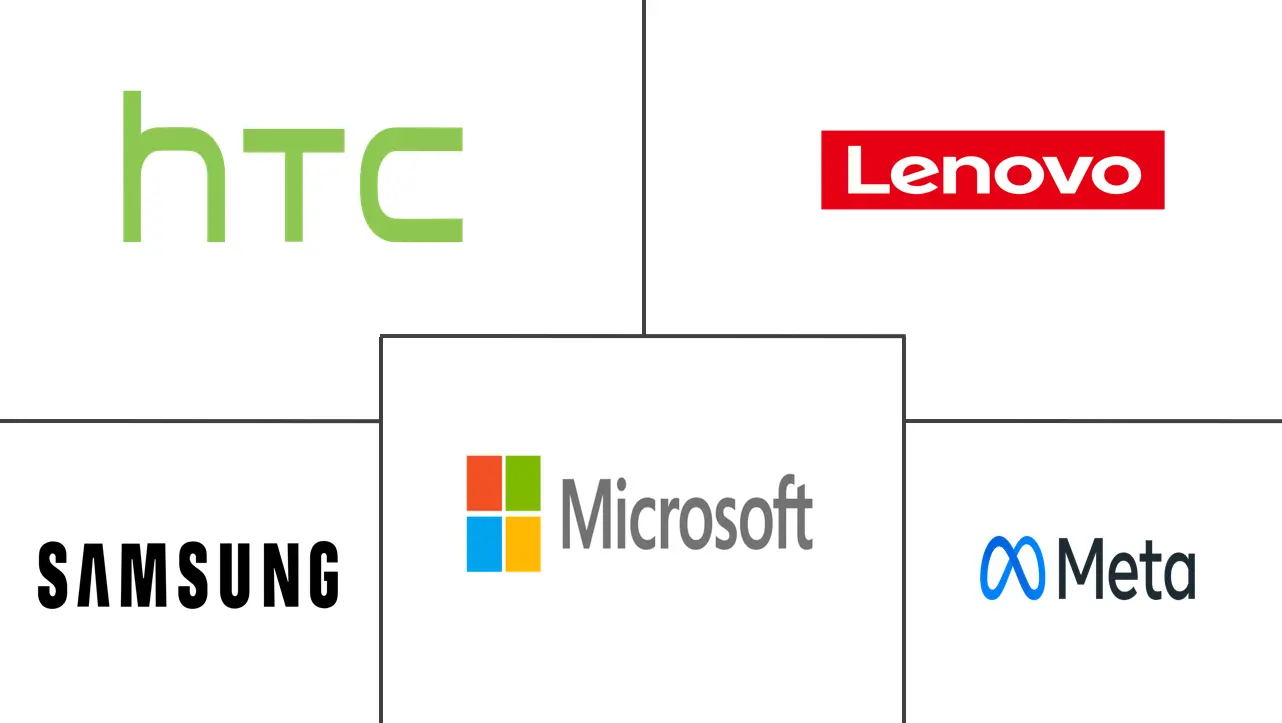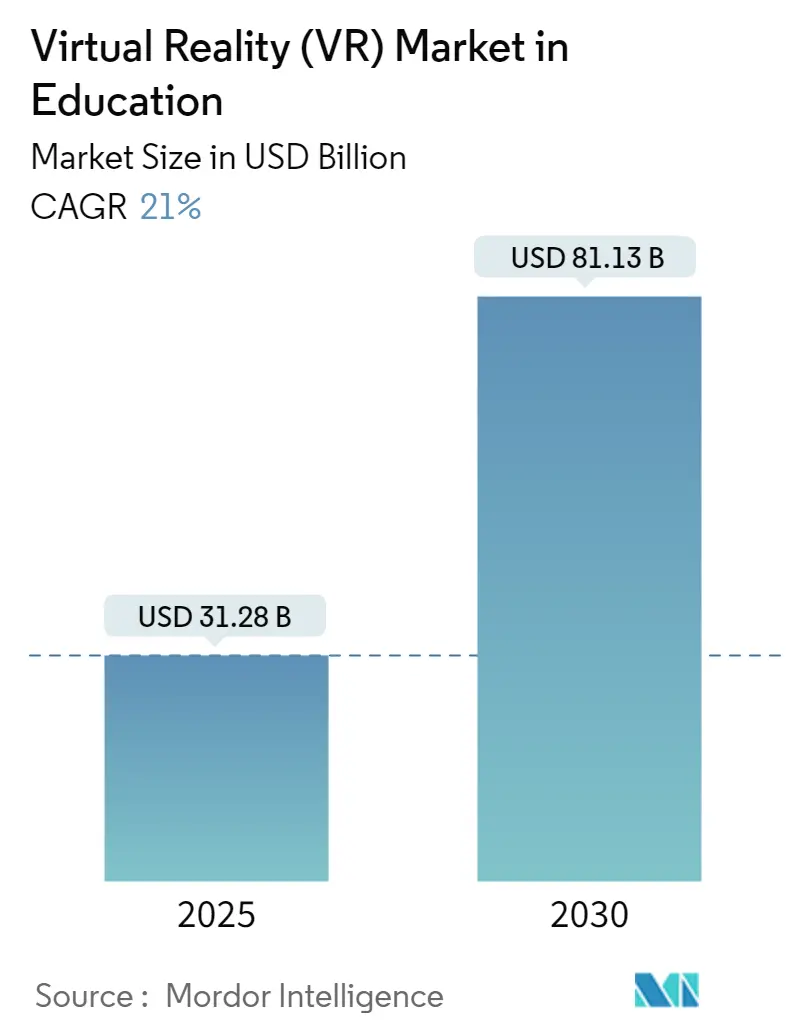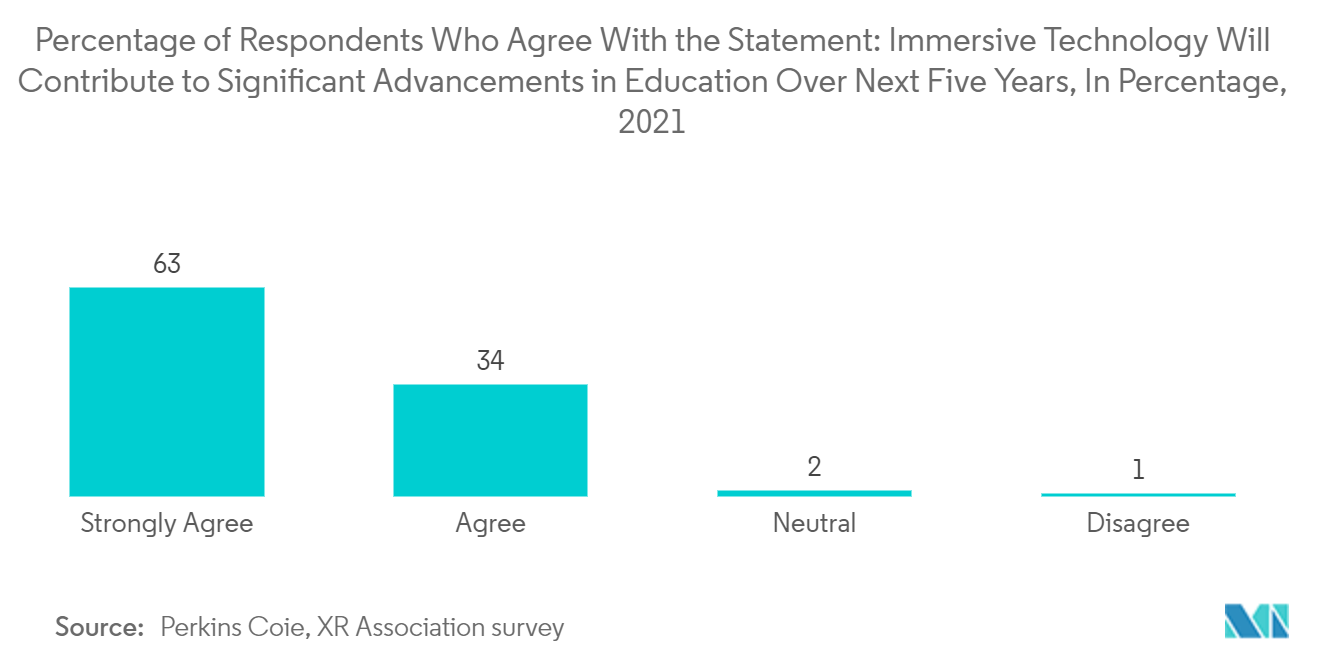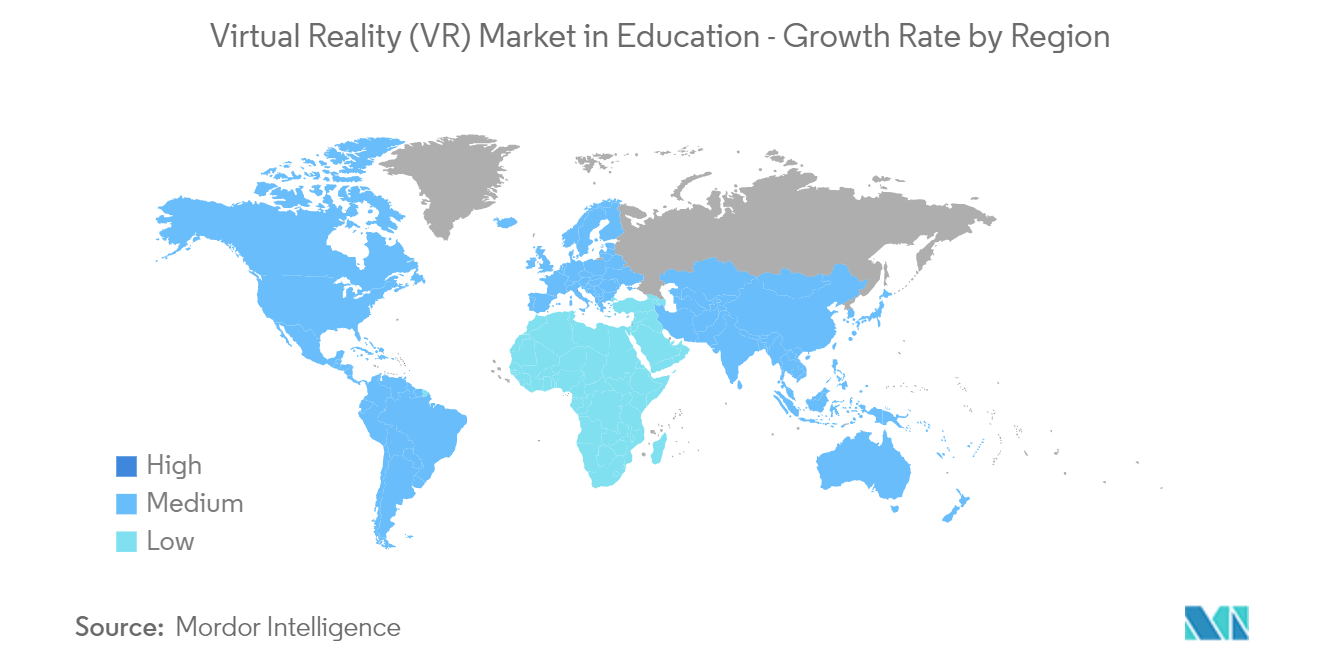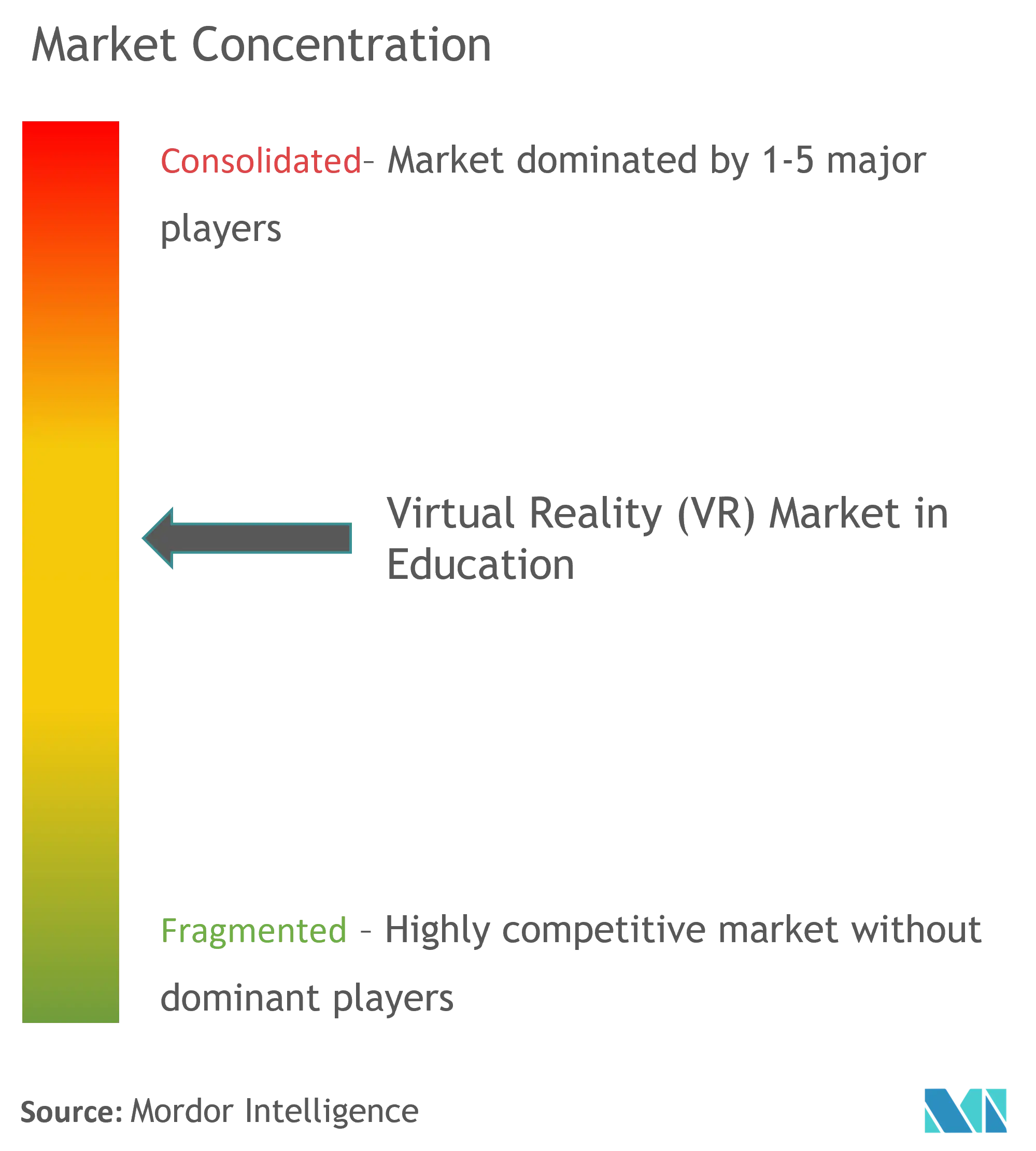Virtual Reality (VR) in Education Market Analysis
The Virtual Reality Market in Education Industry is expected to grow from USD 31.28 billion in 2025 to USD 81.13 billion by 2030, at a CAGR of 21% during the forecast period (2025-2030).
VR technology has gained widespread recognition and adoption over the past few years. Recent technological advancements in this field have revealed new enterprises and adoption among major universities, colleges, and schools for advanced learning experiences. In addition, the market is expected to gain significant demand from corporations for corporate learning programs in the coming years.
- Virtual reality has gained significant traction in the education world over the past few years. It offers learners an immersive experience: they can learn complicated subject matters by entering a reality-imitating virtual world where they can move, talk, make decisions, and interact with the world around them. Such an instance led to increased demand for virtual reality in education.
- Educational institutions have started incorporating practical learning through excursions, lab experiments, group activities, and projects. The introduction of virtual reality in education has taken learning to an entirely new dimension. Immersive learning through Virtual Reality has proven to be an effective tool for expanding knowledge. It delivers digitally created information and situations that mirror real-life experiences that are mostly inaccessible to learners in traditional school settings.
- Many companies are making learning interactive and more engaging through VR technologies by adding gaming elements to textbook material. For instance, Curiscope's Virtuali-tee is a t-shirt and app that lets users learn about the human body. One person puts on the t-shirt while the other uses a virtual reality app on a smartphone to virtually reveal and explore the various layers inside the body.
- Further, VR is finding extensive applications in biology, with universities and colleges worldwide using virtual reality headsets for immersive learning. For instance, last year, students at Arizona State University were learning biology in a unique virtual reality experience, hurtling through space to interact with creatures in an intergalactic wildlife sanctuary the size of a small city and to solve the mystery of why the animals are dying.
- During the COVID-19 lockdown, technologies like AR, VR, and MR witnessed significant demand as they allowed people to shop, talk, and socialize using these immersive platforms. The COVID-19 pandemic moved learners and young students out of the classroom and into the virtual world of remote education. Many universities and schools are now taking advantage of virtual reality technology to improve access to education, both in terms of helping pupils with learning difficulties or disabilities and making learning less location-dependent.
Virtual Reality (VR) in Education Market Trends
Increasing Demand For Interactive and Personalized Learning Experience
- Increasing adoption of online education and the benefits of a virtual learning environment, such as flexible schedules, more individual accountability, mobility, student-centered learning, and others, are driving the market's growth. VR can replace physical paper models, posters, textbooks, and printed manuals. It offers less expensive and portable learning materials, making education more accessible and mobile.
- Over the past few years, the cost of deploying VR has plunged, and the technology has expanded into more general use at almost Fortune 500 corporations, where employees working in retail, logistics, and customer service are practicing with VR headsets to get better at their jobs.
- Various businesses worldwide use VR technology to provide their employees with a personalized learning experience, thus driving the market's growth. For instance, across the U.S., Walmart is training its employees to improve their skills using STRIVR technology, which has also worked for companies like Visa, Bank of America, BMW, Google, ABC, and more. The training simulators place the employee in a realistic setting, which tests their ability to handle different situations at the workplace.
- In K-12 learning, virtual and augmented reality help teachers engage students in content to assist them in retaining knowledge. By using a web-based portal, teachers can control and manage the headsets, plan lessons, and monitor student progress. Teachers can set points of interest on students' headsets to direct them to certain parts of the lesson and may view thumbnail images of what each student is seeing.
Further, as the prices of VR systems drop and more people become interested in this new technology, adoption in the education sector is expected to grow. For instance, a Perkins Coie and XR Association survey of over 160 professionals found that 63% of respondents strongly agreed that immersive technology will significantly advance education over the next five years.
North America is Expected to Hold Major Share
- The North American segment of the market studied is expected to grow significantly during the forecast period, owing to the presence of a large number of vendors, who are also investing heavily in market innovation, coupled with the dominance of the United States in the global software market.
- Globally, it is expected that the United States will be one of the most innovative VR markets. Most of the companies advancing this technology are based in the United States. High technology exposure and the ease of availability of smart devices have created a strong VR market in the region.
- Further, the region has the highest number of emerging startups focusing on bringing innovative VR technologies to various industries. According to data from Tracxn Technologies, as of September 2022, there were approximately 1,348 Virtual Reality startups in the United States.
- According to the GSMA, the number of smartphone subscribers in North America is expected to reach 328 million by 2025. Moreover, by 2025, the region may witness an increase in the penetration rates of mobile subscribers (86%) and the internet (80%), the second-highest in the world. Increased device penetration will positively impact the region's virtual reality market for education.
The telecom companies in the region are aggressively making efforts to attract customers to use their 5G network. Hence, these regional vendors are investing in and innovating the software and platform for the development of VR applications by leveraging the upcoming 5G technology. Such events are expected to boost the growth of the market in the region.
Virtual Reality (VR) in Education Industry Overview
The virtual reality market in education is moderately competitive. Furthermore, research and development initiatives aimed at improving immersive virtual environments' quality, performance, and effectiveness are projected to propel market demand in the coming years, increasing competition among the key vendors.
India in January 2022, had the Central Board of Secondary Education (CBSE) collaborate with the tech giant, Meta, to train 10 lakh teachers and one crore students in Virtual Reality (VR) and Augmented Reality (AR) for the next three years. As part of this partnership, Meta provided a curriculum on digital safety, online well-being, VR, and AR.
Virtual Reality (VR) in Education Market Leaders
-
Microsoft Corporation
-
Samsung Electronics Co. Ltd
-
HTC Corporation
-
Lenovo Group Limited
-
Meta Platforms, Inc.
- *Disclaimer: Major Players sorted in no particular order
Virtual Reality (VR) in Education Market News
- October 2022: Japanese startup Jolly Good Inc., in partnership with Juntendo University, will commence a demonstration project to introduce medical education with virtual reality (VR) and develop human medical resources through VR at Royal Mahidol University and throughout Thailand. The company will provide Mahidol University with VR teaching material production facilities and VR experience equipment to create an environment that enables the self-production of VR teaching materials for infectious disease treatment education at the university.
- May 2022: XR Immersive Tech Inc., a provider of immersive virtual reality (VR) experiences, announced that its recently acquired subsidiary, Synthesis VR Inc., joined forces with VictoryXR in bringing the company's educational content to LBVR operators worldwide, accessible through the Synthesis VR content marketplace. VictoryXR provides virtual reality (VR) educational content for levels starting in kindergarten and up to grade 12.
Virtual Reality (VR) in Education Industry Segmentation
Virtual reality involves the creation of simulated environments that imitate real objects or persons to create an illusion. The creation of such an illusion helps people understand the actual environments of an industry, arena, space, or situation. Virtual reality has applications across various industries, such as education, entertainment, defense, and healthcare, which are projected to bring in key revenues into the global market.
The Virtual Reality(VR) Market in Education is Segmented by Type ( Hardware, Software, and Services (Training and Consulting and Managed Services)), End User( Academic Institutions (K-12 Learning, Higher Education), and Corporate Training (IT and Telecom, Healthcare, Retail, and E-commerce)), and Geography. The market sizes and forecasts are provided in terms of value (USD million) for all the above segments.
| Type | Hardware | ||
| Software | |||
| Services (Training and Consulting and Managed Services) | |||
| End User | Academic Institutions | K-12 Learning | |
| Higher Education | |||
| Corporate Training | IT and Telecom | ||
| Healthcare | |||
| Retail and E-commerce | |||
| Other End users | |||
| Geography | North America | ||
| Europe | |||
| Asia Pacific | |||
| Rest of the World | |||
Virtual Reality (VR) in Education Market Research FAQs
How big is the Education Virtual Reality (VR) Market?
The Education Virtual Reality (VR) Market size is expected to reach USD 31.28 billion in 2025 and grow at a CAGR of 21% to reach USD 81.13 billion by 2030.
What is the current Education Virtual Reality (VR) Market size?
In 2025, the Education Virtual Reality (VR) Market size is expected to reach USD 31.28 billion.
Who are the key players in Education Virtual Reality (VR) Market?
Microsoft Corporation, Samsung Electronics Co. Ltd, HTC Corporation, Lenovo Group Limited and Meta Platforms, Inc. are the major companies operating in the Education Virtual Reality (VR) Market.
Which is the fastest growing region in Education Virtual Reality (VR) Market?
North America is estimated to grow at the highest CAGR over the forecast period (2025-2030).
Which region has the biggest share in Education Virtual Reality (VR) Market?
In 2025, the North America accounts for the largest market share in Education Virtual Reality (VR) Market.
What years does this Education Virtual Reality (VR) Market cover, and what was the market size in 2024?
In 2024, the Education Virtual Reality (VR) Market size was estimated at USD 24.71 billion. The report covers the Education Virtual Reality (VR) Market historical market size for years: 2019, 2020, 2021, 2022, 2023 and 2024. The report also forecasts the Education Virtual Reality (VR) Market size for years: 2025, 2026, 2027, 2028, 2029 and 2030.
Our Best Selling Reports
Virtual Reality in Education Industry Report
The global VR in education market is witnessing remarkable growth, fueled by the demand for immersive learning experiences. Innovations in VR technology are transforming educational content delivery, offering personalized learning and enhancing comprehension of complex subjects through visualization. This growth is evident in the expanding VR training market size, with VR being adopted across K-12, higher education, and vocational training sectors. The integration of VR facilitates engaging, experiential learning platforms, and access to remote locations, despite challenges like compatibility issues and higher setup costs. The demand for VR in education, supporting experiential learning and critical thinking, is expected to surge as the technology becomes more accessible. This trend is further supported by content development tailored to individual learning styles, making education more interactive. The VR in education statistics are on an upward trajectory, promising a substantial market expansion. For detailed insights, Mordor Intelligence™ Industry Reports offer a comprehensive analysis, including market share, size, revenue growth rate, and a forecast outlook. Access a free report PDF download for a snapshot of this industry analysis.

